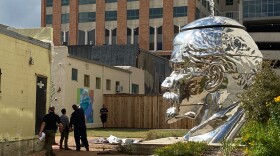Sign up for TPR Today, Texas Public Radio's newsletter that brings our top stories to your inbox each morning.
A Florida man has been sentenced to more than eight years in prison for trying to bomb the Chinese Embassy in Washington, D.C. and a sculpture in San Antonio on a property adjacent to Texas Public Radio’s downtown headquarters.
The U.S. Attorney's Office in D.C. announced the sentence for 45-year-old Christopher Rodriguez of Panama City, Florida.
The licensed attorney and Army veteran previously pleaded guilty in August to charges related to the bombing attempts in 2022 and 2023.
The embassy bombing attempt completely failed, but the sculpture on property adjacent to TPR sustained $325,000 in damage. However, it still stands.
The satirical steel structure is titled "Miss Mao Trying to Poise Herself at the Top of Lenin's Head."
No injuries were reported in either predawn incident.
What appears to be a bomb was detonated under a sculpture next to the TPR headquarters in San Antonio early Monday morning. The sculpture is not on our property.
— Texas Public Radio (@TPRNews) November 7, 2022
This footage is from our security cameras.
The FBI, SAPD, SAFD and other agencies are investigating. pic.twitter.com/NjVn2io26K
In the early morning hours of Nov. 7, 2022, Rodriguez drove from Pensacola to San Antonio. Authorities said he placed two canisters of explosive materials at the base of the steel sculpture in San Antonio, titled “Miss Mao Trying to Poise Herself at the Top of Lenin’s Head.” The sculpture is a traveling art piece that has been installed in several cities in the U.S.
He used a rifle to shoot at the canisters at the base of the statue, causing an explosion that caused significant damage to the sculpture.
The ATF arrested Rodriguez on Nov. 4, 2023, in Lafayette, Louisiana. He was held since that date.
Rodriguez pleaded guilty to damaging property occupied by a foreign government, explosive materials — malicious damage to federal property, and receipt or possession of an unregistered firearm.
The case was investigated by more than a dozen agencies, including the Bureau of Alcohol, Tobacco, Firearms, and Explosives; the FBI’s Washington and San Antonio field offices; the San Antonio field office of the Department of Homeland Security; Homeland Security Investigations; and the U.S. Secret Service.



